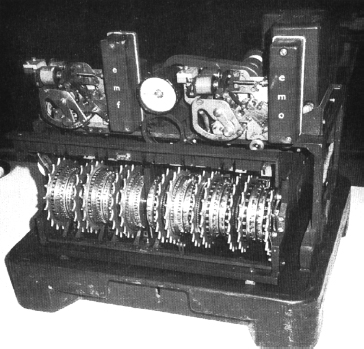6.11 THE LORENZ SCHLÜSSELZUSATZ
The Lorenz Schlüsselzusatz (Fig. 6.16) is an additive encipherment cryptosystem; a key stream determined by more than 501 key bits is XORed to 5-bit Baudot-coded plaintext. The SZ40 was used to encipher German High Command communications. SZ40 ciphertext traffic was referred to as fish [Tutte, 1998]. Both the cryptographic device and the special processor used to carry out the cryptanalysis of the SZ40 were referred to as tunny; this first generation processor was designed by the British General Communications Headquarters (GCHQ) located in Bletchley Park outside London, where the SZ40 cryp-tanalysis activities took place. The SZ40 saga is described in the book by Hinsley and Stripp [2001].
The SZ40 and a succeeding model (SZ42) were manufactured by Lorenz; they were generalizations of the Vernam–Vigenère stream cipher system. The SZ40 encipherment equation is


Figure 6.16 The Lorenz Schlüsselzusatz (Courtesy of NSA).
where
- The plaintext {x(j)} is alphanumeric text encoded into 5-bit strings;
- The key {k(j)} is a sequence of 5-bit strings; and
- The ciphertext {y (j)} is the XOR of the plaintext and key.
The German Cipher Bureau understood the limitations of Vernam–Vigenère encipherment. Even with multiple tapes, an analysis is possible. The SZ40 used ...
Get Computer Security and Cryptography now with the O’Reilly learning platform.
O’Reilly members experience books, live events, courses curated by job role, and more from O’Reilly and nearly 200 top publishers.

